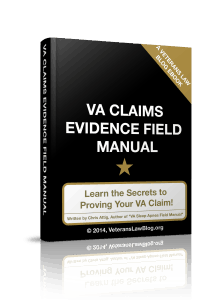If a particular restaurant had a reputation for food-poisoning, would you let them cook your food?
Unlikely.
If a particular doctor had a reputation for hurting his patients, would you let him operate on you?
Ummm…no.
If a particular cab driver had a reputation for driving drunk, would you let him take you to the airport?
Hell no.
So why do most Veterans let the VA develop the record for them?
I don’t know, but I bet that the biggest reason is because Veterans have never been taught a better way.
Let me teach you a better way.
Developing evidence for a VA Disability Claim comes down to 3 things:
Finding the evidence
Deciding whether to put into your C-File
Knowing HOW to put it into the “record” in your VA Disability Claim.
This isn’t just about putting MORE evidence into the file – it is about putting BETTER evidence into the file.
Lay Evidence is the “Magic Bullet” in a VA Disability Claim.
If lay evidence is the Magic Bullet in a VA Disability Claim- and I truly believe it has that kind of power – then medical evidence is the rifle which delivers that bullet to its target.
Without a rifle, the bullet sits in a magazine, powerless.
Without a bullet, the rifle sits in a cabinet and can never be called into action.
So it is with medical and lay evidence. Without lay evidence, medical evidence is devoid of context. Without medical evidence, lay evidence has no real power.
Let’s talk about these two types of evidence.
The 2 general types of evidence in a VA Claim: Lay evidence, and Medical Evidence.
Lay evidence is, at its core, observations and facts that are documented by people without specialized professional knowledge.
Your buddy’s statement that you both were assigned to guard duty 50 yards from a burn pit in Iraq is lay evidence of an in-service event (Pillar 2)
Your spouse’s statement that you don’t sleep more than 30 minutes at a time throughout the night and keep a loaded pistol under your pillow is lay evidence of symptomatology of your mental health conditions (or possibly sleep apnea)
Your statement that a doctor in Vietnam diagnosed you with malaria in 1971 is lay evidence of a contemporary diagnosis.
Medical evidence is the evidence provided by medical professionals: medical treatment notes, diagnoses, medical evaluations and opinions, etc.
C&P Exams are medical expert evidence
Private/Independent Medical Exams are medical expert evidence
Service Medical Records, and post-service medical records are medical evidence.
2 Common Evidence Errors in your VA Disability Claim.
I have reviewed hundreds, if not thousands, of Veterans C-Files. In doing so over the years, I have seen 2 common errors that Veterans (and a lot of their VSOs) commit.
Category 1: The Veteran or VSO relies too heavily on medical evidence.
I see this a lot in Sleep Apnea claims – typically, you will see the Veteran or his VSO provide an abundance of medical evidence of diagnosis, sleep studies, treatment plans, prescriptions for use of CPAP, etc. This category of Veteran or VSO often does not include lay evidence that shows how the condition is impacting his daily life activities.
Category 2: This Veteran or VSO relies too heavily on lay evidence.
Typically, the Veteran or VSO either omits medical evidence or puts the burden on the VA to generate the medical evidence.
The VA will fill the void and produce or create the medical evidence (through selective inclusion of health records and poor quality C&P Exams), resulting in an outcome that the Veteran is not happy with.
There is a 3rd Way.
Medical Evidence and Lay Evidence work together.
They are like peanut butter and chocolate.
Summer and Margaritas.
Bonnie and Clyde.
Together, they are far more powerful than they are separately.
Consider this:
38 CFR 4.10 (2013) tells us that medical examiners are responsible for providing a “full description of the effects of disability upon the person’s ordinary activity”
Where do medical examiners get this information? Veterans. In the form of lay evidence.
38 CFR 4.2 (2013) tells us that the examiner has to reconcile the various reports into a consistent picture “ ..so that the current rating may accurately reflect the elements of disability present.”
If the examiner has only the Veteran’s statements on a VA Form 21-4138, what is there for the doctor to reconcile? Nothing – other than the examiners own background and experience.
This is why so many Veterans are frustrated by C&P examiners that don’t seem to believe them, or who don’t understand the full scope of the problems they face. The C&P Examiner has never been given the FULL picture of the Veteran’s disability and does not understand the limitations on the Veteran’s Daily Life Activities.
What if there was a wealth of lay evidence in a VA Disability Claim showing the WHOLE picture of the Veteran’s disability?
Most Veterans don’t paint the “whole picture”. The result is that they are dissatisfied with the VA Disability Claims Process.
By contrast, when my law firm paints this picture, we find that VA Disability claims and appeals get granted more efficiently and more thoroughly.
So, what if all of the lay evidence in a VA Disability Claim – from a wide variety of people, not just the Veteran? What if there was a wealth of evidence talking about the Veteran experiences in and after military service, such as:
What the Veteran’s spouse sees and observes?
What the Veteran’s co-workers see him/her doing or not doing at work?
What friends observed about how he/she has changed since returning from military service?
What extended family observe, if only a couple times a year?
What if the medical examiner had access to all that information?
What if the Veteran’s Treating Physician understood more about how the Veteran’s condition affects daily living activities?
Here’s what happens: Treatment changes and improves. Opinions from C&P Examiners improve. It becomes harder and harder for examiners to paint a picture that is unfavorable to the Veteran.
BVA Decisions increase in quality, because they have MORE evidence on which to “hang their hat”.
Now, it is important to know that lay witness testimony – alone – can be sufficient to substantiate a claim for service connection of an injury. Horowitz v. Brown, 5 Vet. App 217 (1993).
It is error for the BVA to require medical evidence to support lay evidence. See, Horowitz.
However, just because the BVA and the VA can’t require lay evidence to corroborate medical evidence doesn’t mean that you shouldn’t provide it.
You can win with just lay, or just medical, evidence.
But if you have the opportunity to use both, you might just find that you have a different experience in the VA Claims Process.
Learn More About Lay Evidence in this Veterans Law Blog Field Manual.
I have written a Field Manual (an eBook) giving you more information about lay and medical evidence in a VA Disability Claim. Click here, or on the image below, to learn more.








I am currently unemployable. I am at 70% but would like to see 100%
This is great
A most informative and important article that all veterans should read and use in the processing of their claim.
Without knowing I submitted my claim using supporting documents from my Platoon leader, fellow aviators, my wife and co workers. This with the medical evidence, proof of specific incidents enemy engagements with dates, locations, aircraft numbers and unit records my claim only took a little over 90 days to be approved.
all info is good , I looked at my file it said under my PTSD (70% perm) I am unemployable so I am now going to file for that .( I am 100% Perm)
Thanks
Clay